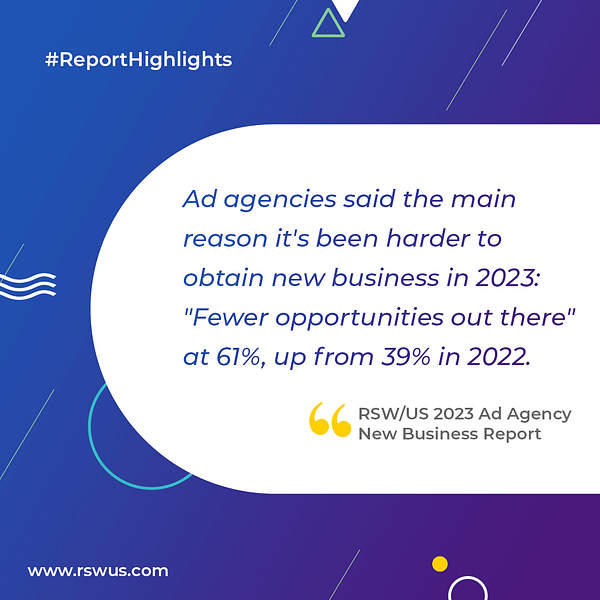Why Is It Harder To Obtain New Business?
So 2023 has been kicking small and mid-sized agencies around so far this year from a new business standpoint, and in this second post in a series, we explore the question, Why Is It Harder To Obtain New Business?
Per Jeff Graham, President of Cactus in Denver, (2023: The struggle is real)
The first three quarters of this year have been somewhere between a head-scratcher and a dumpster fire — but the rest of it doesn’t have to be.
If agencies stay focused on the spaces where we have a right to win; empathize with the unique pressures our clients are facing and eradicate risk; and capitalize on this moment and create our own luck, then there’s hope for 2023 — and a brighter 2024 yet.
Couldn’t agree more with Jeff and his optimistic take, but as he points out, agencies have some work to do.
As I pointed out in my previous post (Ad Agencies Struggled with New Business in 2023-So What’s Next), 58% of agencies said it’s been harder or a lot harder to obtain new business this year so far.
So in order move forward and embrace a more profitable 2024, I want to explore the reasons why agencies found acquiring new business to be more difficult in 2023, and look at those areas agencies have control of.
Taken from our RSW 2023 Agency New Business Report, we asked agencies:
Why Is It Harder To Obtain New Business?
In previous surveys, agencies have unilaterally given “breaking through to prospects” as the main reason why it’s harder to obtain new business.
This year, for the first time ever, it comes in third.
So what follows is a breakdown of the top 8 reasons:

Fewer Opportunities Out There (61%):
At the forefront of the challenges identified in our survey is the perception that there are simply fewer opportunities available.
Competition, to be fair, contributes to a more limited pool of opportunities. The ad agency world is a crowded market.
The question I would ask, in the spirit of tough love, is: How regularly did you actually pursue new business in 2023?
I do think for many small and mid-sized agencies, perception, as used above, is the key word here.
If your firm is not actively pursuing new business in some form, then there will, by definition, be fewer opportunities.
That is not to take away from the very real situation of marketers and budgets pulling back in 2023-that you cannot control, but if a plan for new business you can control.
Prospect Budgets Too Small (55%):
It should be noted that agencies in our survey are not referring to client budgets (which also saw reductions) but prospect budgets for potential work. A 2023 report from Survey Monkey (2023 Marketing Report: Top challenges and opportunities) pointed out
33% of marketers say their budgets will decrease or stay the same in 2023.
From our own 2023 New Year Outlook Survey, only 36% of agencies believed their clients would increase marketing spending somewhat to significantly, a 37-point drop at that point from 2022.
So agencies had a gut feeling on this at the outset of the year, and indeed, anecdotally, we did see some pullback from marketers.
And post-pandemic, many agencies were able to pick and choose projects and had it really good. Those same agencies got a jolt around Q2.
So moving into ‘24 would be the time to potentially consider smaller opportunities in the short term, that are, critically, still within your wheelhouse, in order to land and expand.
Harder to Break Through to Prospects (47%):
While no longer the primary challenge, breaking through to prospects remains a significant hurdle.
Without a doubt, it’s never been harder, but at the same time, the amount of useless emails and outreach overall make it harder for you to break through, but it also provides you with an opportunity.
An opportunity to use messaging that does two critical things: 1) Show your agency expertise and 2) how it can help solve their business challenges.
I am continually shocked with the lack of these two elements in prospecting outreach.
Always make sure you show what’s in it for them!
Prospects Go Dark (37%):
Not a new trend but endlessly frustrating.
However, remember that a lack of response doesn’t always mean lack of interest.
You have to remember how busy your prospects are, and how much noise surrounds them-professional and personal.
If this is happening more often that not, here’s a step-by-step “ghosting follow up schedule” to help you stick with your prospects if they’re ghosting you – and more importantly – help you get a clear yes or no from them, so you can move forward or move on.
You’ll find 3 email templates and 1 VM template you can adjust as needed to fit your situation.
Can’t Find the Right Person (15%):
Identifying and reaching the key decision-makers within a potential client organization remains a persistent challenge, and the first key is making sure you’re going after the right titles.
That may sound entirely obvious, but it’s a problem for many agencies.
Key here is to do the homework up front, and be sure to differentiate between who you actually work with ongoing within a client’s company versus the decision maker you’re reaching out to when prospecting.
They’re not always the same person.
No Process in Place (13%):
Establishing clear methodologies for lead generation, qualification, and conversion is, of course, imperative.
We’ve discussed before in our ongoing content, that the first step is forcing yourself to take this first step.
The only one to blame for no process is yourself, but of course that doesn’t mean you may not need help.
The Resources dropdown on our home page has a lot of info to help you get started, or restart.
No Time to Do It (11%):
See above.
As easy as it is to say, time must be made.
Making a plan you can actually stick to is the first step.
Can’t Make the Investment (5%):
This is certainly legitimate, but you also don’t need a large outlay of cash to go after new business initially.
Looking at the 4 key areas of business development( referrals, organic growth, inbound/content, and outbound), you already have the tools to handle all four of those with no additional cash outlay.
As you progress, however, yes, you will need other tools, like a CRM, for example, but an internal business development process (if you’re not hiring someone solely dedicated to the job) does not require a large investment to start the process internally.
In Part 3 of our series we’ll talk hiring for the new business director position.


